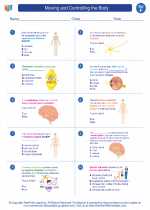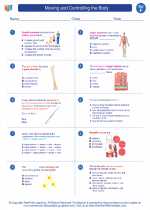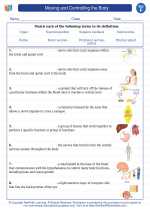Muscles
Muscles are soft tissues found in the human body that have the ability to contract and produce force. There are three main types of muscles in the body: skeletal, smooth, and cardiac muscles.
Skeletal Muscles
Skeletal muscles are attached to the bones and are responsible for voluntary movement. They are striated, meaning they have a striped appearance when viewed under a microscope. Skeletal muscles work in pairs - when one muscle contracts (the agonist), the other relaxes (the antagonist).
Smooth Muscles
Smooth muscles are found in the walls of internal organs, such as the stomach, intestines, and blood vessels. These muscles are not under voluntary control and are responsible for involuntary movements, such as peristalsis (the movement of food through the digestive system).
Cardiac Muscles
Cardiac muscles are found in the walls of the heart and are responsible for pumping blood throughout the body. These muscles are also striated, but unlike skeletal muscles, they are involuntary and contract rhythmically to maintain the heart's function.
Functions of Muscles
Muscles have several important functions in the body, including:
- Movement: Muscles allow for voluntary and involuntary movements of the body.
- Posture and Support: Muscles help maintain posture and provide support for the body.
- Heat Production: Muscles generate heat as a byproduct of their activity, helping to maintain body temperature.
- Protection: Muscles protect internal organs and structures.
Study Guide
Here are some key points to remember when studying muscles:
- Identify the three main types of muscles in the body and their respective functions.
- Understand the structure and function of skeletal muscles, including the concept of agonist and antagonist muscles.
- Explain the role of smooth muscles in involuntary movements and their presence in internal organs.
- Describe the unique features of cardiac muscles and their function in maintaining heart health.
- Discuss the various functions of muscles in the human body, such as movement, posture, heat production, and protection.
By understanding the different types and functions of muscles, you can gain a comprehensive understanding of how these essential tissues contribute to the overall function of the human body.
[Muscles] Related Worksheets and Study Guides:
.◂Science Worksheets and Study Guides Sixth Grade. Moving and Controlling the Body

 Worksheet/Answer key
Worksheet/Answer key
 Worksheet/Answer key
Worksheet/Answer key
 Vocabulary/Answer key
Vocabulary/Answer key
 Vocabulary/Answer key
Vocabulary/Answer key
 Vocabulary/Answer key
Vocabulary/Answer key
